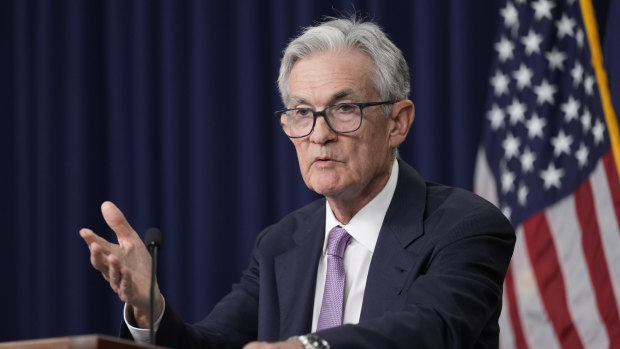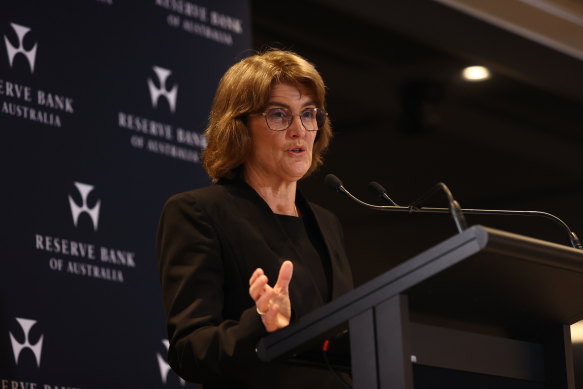This was published 7 months ago
US cuts interest rates, turning up heat on RBA
By Shane Wright
The world’s most important central bank, the US Federal Reserve, has cut its key interest rate by half a percentage point, jolting financial and commodity markets while putting pressure on Australia’s Reserve Bank to bring forward its own plans for rate relief.
After its two-day meeting in Washington, the Fed’s interest rate setting committee decided in an 11-1 vote to bring its key lending rate down to a range between 4.75 and 5 per cent.

US Federal Reserve chairman Jerome Powell says the bank has made a “good start” with its half percentage point cut in its key lending rate.Credit: AP
It is the first cut by the Federal Reserve since the early part of 2020, when it took rates down to zero in a bid to deal with the COVID-19 pandemic. It started lifting rates in March 2022 and in July last year took them to their highest level since just before the global financial crisis.
Prime Minister Anthony Albanese and Treasurer Jim Chalmers on Thursday played down hopes the Reserve Bank would follow suit in the near term as the local sharemarket and dollar bounced higher on the Fed’s decision.
Federal Reserve chairman Jerome Powell, in his post-decision press conference, said the US bank’s “recalibration” of interest rate settings should ensure strength across both the economy and America’s jobs market.
The Fed expects a lending rate of about 4.4 per cent by the end of this year and about 3.4 per cent by the end of 2025.
Powell said the half a percentage point rate cut gave the bank options as it dealt with changes in the economy.
“We can make a good strong start,” he said. “We can go quicker if that’s appropriate, we can go slower if that’s appropriate, we can pause if that’s appropriate.”
The Fed now joins the Bank of Canada and the Bank of England, which meets on Thursday, among the world’s large central banks to start cutting interest rates. The Reserve Bank of New Zealand has also started cutting rates.
The Reserve Bank was later than other central banks in starting to lift interest rates, which it did in May 2022. Australia’s cash rate, at 4.35 per cent, is still lower than the lending rates in the US, New Zealand and Britain, while Canada’s most recent cut took its interest rates down to 4.25 per cent.
Reserve Bank governor Michele Bullock has attempted to push back expectations of a near-term rate cut in Australia.
Chalmers, among others, has warned the RBA’s interest rate settings have smashed the economy, which has expanded by just 1 per cent over the past 12 months.
On Thursday, he noted rates had gone up by more in the US since the pandemic than in Australia.
“When the Reserve Bank meets next week they will consider a whole range of things including that, but they’ll be primarily focused on inflation, as the government is,” Chalmers told Nine’s Today show. “Inflation had a six in front of it when we came to office, it’s halved since its peak in that year that we were elected, but we need to see it come down a bit more.”

Governor of the Reserve Bank of Australia Michele Bullock. Ahead of the Fed decision, financial markets in Australia put the chance of a rate cut at the RBA’s December meeting at 97 per cent.Credit: Dominic Lorrimer
Albanese said interest rates in Australia were still lower than in the US even after the Fed’s move, as well as in countries such as Great Britain, where the key lending rate is 5 per cent.
“What we are managing to do is to try to land a decrease in inflation, which we have cut in half, whilst continuing to create employment,” he said.
Economists at both Westpac and the Commonwealth Bank expect data next week to show the annual rate of inflation through August falling to 2.7 per cent.
Figures from the Australian Bureau of Statistics released on Thursday showed the unemployment rate steady at 4.2 per cent in August, with 978,000 jobs created since Albanese came to office in May 2022.
There were 47,500 extra jobs created in the month, but all were part-time positions. Full-time jobs fell by 3000, with the largest drop in NSW, which shed almost 8000.
Opposition Leader Peter Dutton said interest rates in Australia would already be falling if not for government spending.
“The Reserve Bank governor keeps pleading with the prime minister to not spend as much money in the economy because it’s inflationary, and inflation drives up interest rates, and interest rates are coming down in comparable economies, but they’re not coming down here, and they should already be down,” he said.
But ANZ senior economist Catherine Birch said the ongoing strength in the Australian jobs market might delay any rate cuts by the Reserve Bank.
“While we continue to expect the RBA to start its easing cycle in February 2025, the risks look to have tilted to a later rather than an earlier start, particularly given the current momentum in the labour market,” she said.
Ahead of the Fed’s decision, financial markets in Australia put the chance of an RBA rate cut by the end of the year at 90 per cent but pulled it back to 72 per cent after the jobs figures. The same markets have another four cuts priced in by the end of next year which, if they were to occur, would take official interest rates down to 3.1 per cent.
Cut through the noise of federal politics with news, views and expert analysis. Subscribers can sign up to our weekly Inside Politics newsletter.